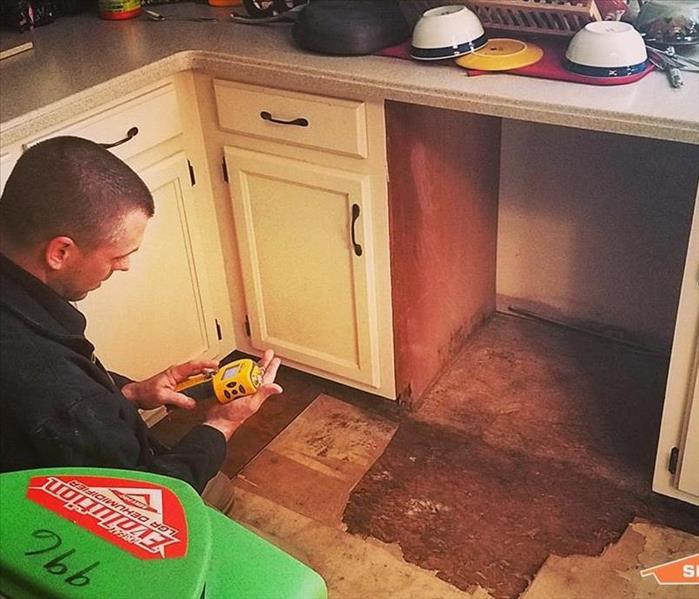Common Moisture Problems That Can Lead To Mold
5/24/2017 (Permalink)
Why does mold grow?
Any discussion about mold cleanup should start with understanding why mold begins to grow in the first place. Customers with a mold damage problem are always surprised to learn that toxic mold spores are present not just in their home, but every home, and in fact almost every environment. It’s a naturally occurring element and in low levels is completely safe to humans and pets and your home in general. So when does it become a problem? When too much moisture is introduced in the organic surfaces mold feeds on to grow. Things like drywall, insulation, wood, cabinets, etc. become mold’s food source when mixed with water and the right temperature. While there are many strains of toxic mold, most thrive in temperatures ranging from 60-80 degrees Fahrenheit. If you’ll notice, the average temperature in home’s ideal to our own comfort sits squarely within that range. So when it comes to mold growth, 2 things are always present: the right temperature and food. It’s when you introduce that 3rd element, water, that problems can quickly grow out of hand!
Most common moisture problems that lead to mold
If your home suffered a massive water damage event, you’re obviously going to know about it and hopefully you’re going to hire a competent water damage restoration company to fix it (hint hint, that’s us!). So the likelihood of that event unleashing a chain reaction that leads to a big mold problem is small assuming you have the moisture removed quickly. The real big mold jobs we see are from much smaller, long-term moisture problems that just never went diagnosed. Below are some of the most common persistent water damage problems we see that can result in a massive amount of black mold damage.
Leaks under sinks
Whether it’s from a supply line with a loose connection or a drain pipe that has a small hole, slow leaks under seats (or any other sink for that matter) can go unnoticed for some time because your cabinets can hide the problem. It’s always a good idea to check under your sink cabinets to look for any signs of moisture or musty odors. If you detect a problem, it may be a good idea to have a professional come out and inspect things further. In some cases the problem is isolated and will be something you can handle on your own. But in some cases, the visible signs are only the tip of the iceberg. You’d be shocked what we have seen on and in walls and under flooring after pulling out cabinets!
Small roof leaks
In some instances, the symptoms of a significant roof leak are discovered pretty quickly. Usually you see discoloration in the top floor’s ceiling or worse, it collapses entirely. But in other cases when you have a very small leak, the problem can go undetected for quite some time and never result in water damage you can see from inside the home. It’s usually discovered when someone goes up into the attic for some unrelated reason and sees the problem: mold growth everywhere. On the roof decking, insulation, support beams, you name it. At that point, you’ve got an expensive problem on your hands and your insurance company likely isn’t going to pay for the damages.
The best way to prevent this particular mold problem from occurring is to perform both an exterior as well as interior inspection at least once a year. For the exterior, actually walk the roof of your home (if it’s safe) to look for damaged or missing shingles. Replacing them is easy! For the inside, climb up to your attic and inspect the roof decking for signs of water intrusion.
Pipe leaks inside walls
A lot of times we are called to a home to do a mold inspection because a homeowner noticed a small patch of mold growing on the floor next to a wall. When we dig further, we usually discover there is a plumbing pipe housed in that wall that is slowly leaking and depositing water on the floor inside the wall cavity. Once we start to remove the drywall, often times we discover the problem is much larger than just the small visible spot on the floor. Usually the mold has traveled throughout the wall cavity and inside the subfloor. The damage can be extensive and the costs high.
You obviously can’t go tearing out sections of your walls often to figure out if you have a problem, so what can you do? The main thing you should be doing is watching your water bill. If you notice a spike and can’t determine a cause for that spike, you may have an undetected leak. At that point, you may want to hire a leak detection company to come out and perform an inspection to determine if you have a bigger problem you need to deal with. They’re better equipped at finding the problem, at which point we would come in and remove the excess moisture and black mold as well as repair any surfaces or structures that were torn out during the process!
Mold In Your Home? Call SERVPRO of Bullitt & N. Nelson Counties 502-904-0710.




 24/7 Emergency Service
24/7 Emergency Service
